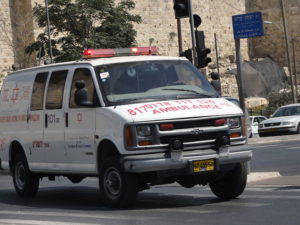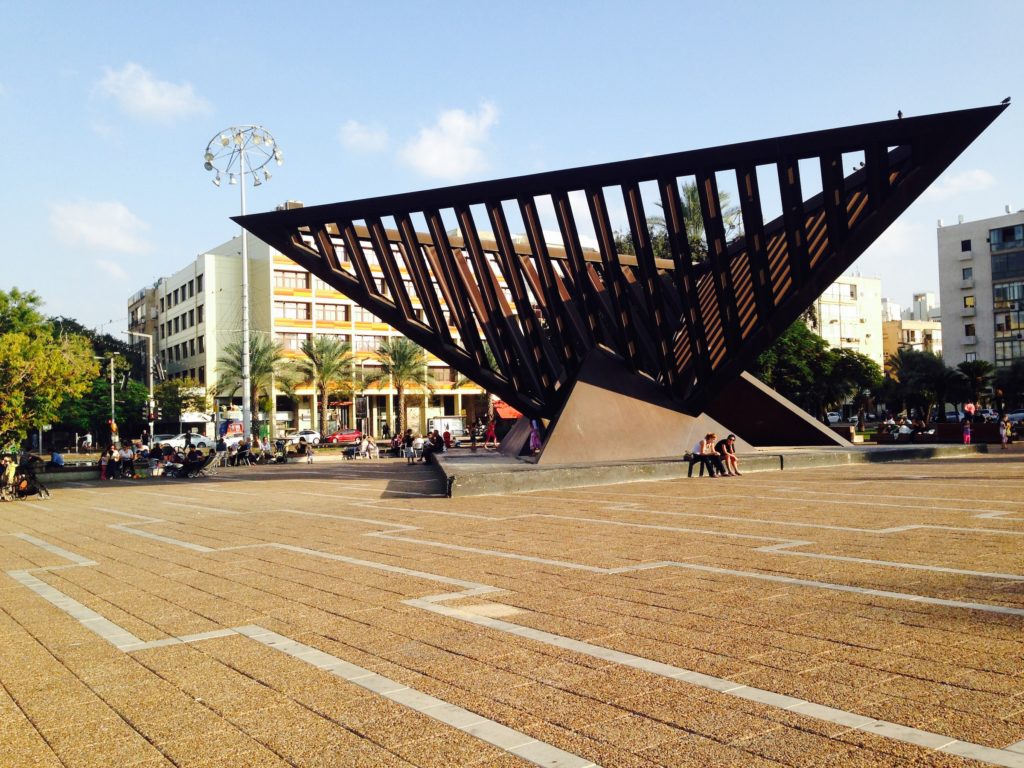 Last night I got 3 hours of sleep. I took a taxi to the central Magen David Adom station (buses don’t run on Shabbat) and sat on the bench outside reading the newest issue of Rolling Stone magazine.
Last night I got 3 hours of sleep. I took a taxi to the central Magen David Adom station (buses don’t run on Shabbat) and sat on the bench outside reading the newest issue of Rolling Stone magazine.
In front of me I see a Natan ambulance getting ready to start its shift and I see that it only has a driver and a medic (no volunteers).
Overseas volunteers are usually only allowed on the regular Lavan ambulances not the Natan ambulances. The Natan ambulances have more advanced life support technology (IV’s, drugs, heart monitor).
They asked me if I would like to join them and I enthusiastically replied, “Yes!”
Even though we’re not supposed to go on them “technically” all of us volunteers have been itching to get on the Natan ambulances, because their calls are more exciting. I was very glad it was Shabbat morning and so nobody else had wanted a shift.
The medic gave me a short introduction to the new technology on the ambulance and had me check the oxygen.
After relaxing in the station for a bit, we received a call. We started driving, but at a normal pace and without the siren. At this point I was expecting to help an old woman to the hospital.
We arrived to the house. I placed the ambulance bag (contains CPR gear) onto the stretcher and pull it out onto the sidewalk. I slung the doctor bag (filled with drugs) and oxygen tank onto my back. The driver grabbed the heart monitor. The female medic grabbed the “small bag” which is the CPR bag for babies and toddlers. My heart skipped a beat. I couldn’t process that information and was not ready for what I was about to see.
As I walked through a hallway I was met with a cacophony of misery. I heard the sound of frantic, heart wrenching screams in Arabic from the grief-ridden family added to the yells in Hebrew from the police and MDA officials. I walk past them and watched as several teenager Israeli volunteers were performing CPR on a 4-month-old Ethiopian baby girl.
Everything from this point on became surreal. None of what I saw felt real. It was as if I was watching a movie and narrating it to myself in my head.
The little baby girl looked so fragile and small, frighteningly small. The medic hooked up the heart monitor to the baby in seconds as I watched frozen in place.
The small child now had a multitude of wires protruding from her body. I watched as each time the volunteer performed a compression her thin arms lifted up a few inches into the air.
The medic took out an an adrenaline shot, informed us she hated this part, placed it on top of the baby’s kneecap and pushed it in until we heard the snap that signaled the drugs had been inserted. Per her request, I gave her gauze and whatever else she required.
I looked around me and nobody in the room had a look of worry on their faces. The Israeli volunteers performing CPR were smiling. There were even a few laughs shared between the Magen David Adom personnel. None of which was done out of insensitivity, it’s just that they’re used to seeing this kind of emergency situation and a stress-free environment is a more safe and efficient one.
I watched the heart monitor religiously. My body flooded with joy when I saw her heart rate move up and down, and my thoughts grew grim when her heart rate appeared systolic.
I was completely helpless. I felt like I was watching this little girl die and there was nothing I could do.
My medic asked for a clean blanket from the family, wrapped the baby in it and instructed us to return the gear back to the ambulance.
As we were walking down the stairs I asked the driver what we could do in the ambulance, he told me that we can’t do anything…just bring her to the hospital faster.
The heart monitor stayed connected as the medic performed compression while she took the baby down the stairs and into the ambulance. As we stepped into the ambulance, the medic told me to plug the oxygen into the ambulance hand pump.
I’ve begun narrating to myself what’s happening because I can’t accept the reality of the situation. Talking to myself as if I’m blogging what I’m seeing. Desperately trying to find some way to process and escape this atrocity.
I slap myself out of my haze and grab an oxygen mask, tear off the plastic and rip off the mask. With the rush I didn’t realize that I put the wrong end of the tube onto the mask. The ends were still airtight.
My mistake didn’t occur to me until later and then it wracked my body with fear and guilt. Afraid of the answer, I later asked my medic about my mistake. She told me that it was not a problem, and that it wouldn’t have mattered if I hadn’t even connected the oxygen. What was important was that I had readied the hand pump quickly.
The ambulance drove off towards the hospital.
I grabbed the baby ambulance air pump and watched as the medic performed compressions by pressing her fingers gently but firmly against the baby’s chest. When my medic’s hand completed one round of compressions I tilted the baby’s head back and gave her two deep breaths of oxygen.
We repeated this process over and over. As I was staring down at this baby girl with her eyes firmly closed, I was thinking in my head, “WAKE UP!! CRY!!! SCREAM!!! LAUGH!!! ANYTHING!!”
Suddenly I realized that I needed to focus and that the breaths I was giving the baby were too fast.
My brain was hit hard with a memory from the MDA course in Jerusalem when my instructor, Itamar, would watch and critique me while I performed CPR on plastic dummies. Itamar is a 23-years-old Israeli man with fluent English, a presence that lights up a room and served as a bro/teacher for our MDA class. When I practiced CPR in front of him, I was always worried about messing up because I knew he would call me out. One time in class, Itamar came over to me while I was giving respiration breaths to a dummy, and told me that I should squeeze slower on the hand pump because nobody breathes as fast as I was pumping. At the time I chuckled at his suggestion, but now I’m very grateful for his attention to detail.
The flashback broke. I relaxed my own body and began giving the baby longer, slower breaths.
When we reached the children’s hospital, I held onto the oxygen tank with one arm and the oxygen pump with the other as we continued to give CPR to the baby as we walked to the emergency room. Once we arrived at the room, the baby was quickly placed onto a doctor’s chair where six personnel worked in a hurried frenzy to save her life. Her clothes were torn off and replaced by tubes and syringes. Compressions were given. I heard the heart monitor begin to beep. I stayed for a bit and watched, hoping that in a few minutes I would see the doctors rejoice and shake hands as the baby would begin to cry, like a movie. However, emotionally I couldn’t continue watching and stepped out for a bit. I washed my hands just to do something to distract my mind.
As I was walking back to the room, I struck up a conversation with one of the young Israeli volunteers about where I was from, how long I’d been in Israel etc. He informed me that the young baby had Tuberculosis and that we might need to get X-rays to get tested. Woah. My brain felt like it was ready to pop. I later learned that since the exposure to the baby was so short we don’t have to worry.
I listened as the mother of the baby informed our medic about what had happened, using a friend who spoke Hebrew. We learned that the baby had been puking incessantly, not sleeping and had spent 6 days in the hospital last week. The worst news, the baby had been unconscious for 3 hours before they called Magen David Adom. Rather than call an ambulance they covered the baby’s face with a blanket and assumed that she was dead. Hearing all of this, I felt sick to my stomach and went outside for some air. I sat on a bench outside with my head between my legs for half an hour trying to breath and put things together in my head.
20 minutes later I learned that the 4-month-old girl had been pronounced dead.
I know that I saw death on my first day of Magen David Adom, but this was different. Rather than the death of a 72-year-old woman, this baby girl was only 4 months old. 4 damn months!! She didn’t get the chance to walk, speak or experience the world. This was a life that was taken before it was lived. The idea that kept pounding in my head was, “how can we complain about our lives when others don’t get the chance to even live?”
I’m used to seeing babies like my nieces. Adorable, wide-eyed, chubby bundles of joy with an ineffable magical quality.
Babies that cry, laugh, smile and poop.
I believe that babies are the epitome of life, due to their “newness”.
Thus I couldn’t believe I had just watched an infant die. Not to be crass, but death is for the elderly.
So…
What did I learn from this experience and the many others as a volunteer in Magen David Adom?
Well, I already knew that…
the world isn’t fair.
the human body is fragile.
death is a part of life.
But Magen David Adom forced me to put my own fears second by giving me 100 cc’s of reality into my veins.
When I felt uncomfortable consoling and having conversations with my patients, I learned to get over it and began speaking Hebrew, which created deeply meaningful dialogue. At the beginning of MDA I was very afraid to see death, saw it on my first day, and acted professionally the entire time. I learned to incorporate the Magen David Adom value of putting others before yourself into my life.
Basically…
I’m a healthy 19-year-old with a loving family and a future to accomplish whatever I set my mind to…what’s to fear?
Special anonymous thank you to the driver and medic that I worked with today. They supported me and I’m eternally grateful. Oh and the ambulance number was 18 (Chai), aka God needed to make sure I got the point. Life goes on 🙂
On my way back home I rented one of Tel Aviv’s green bikes to settle my nerves and embraced the beauty of Tel Aviv.

(Photo: Wikimedia Commons)

